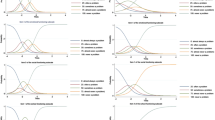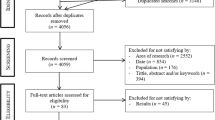Abstract
The French Health Ministry, stating the limits of traditional indicators to take into account the different aspects of adolescent health, declared adolescent health status assessment as a priority. Thus a French health-related quality of life (HRQL) generic self-administered indicator was developed on the adolescent's viewpoint for healthy and ill adolescents of 11–17: the VSP-A, Vécu et Santé Perçue de l'Adolescent, intended to be used as a discriminative, predictive and evaluative instrument. This paper reports the validation study of the 40-item VSP-A including 2941 adolescents. Six dimension scores were computed: psychological well-being, energy, friends, parents, leisure, school, as well as an index. Content and construct validity were confirmed. Factorial validity was shown. As expected, scale scores were significantly associated with a one-item global well-being visual analogue scale (r = 0.53; p < 0.001) and with a self-esteem score (r = 0.62; p < 0.001). On the VSP-A index, girls and older adolescents were found to have the lowest scores. The VSP-A is reliable in terms of internal consistency (Cronbach's α = 0.83) and test–retest results (r = 0.69; p < 0.001). The ability of VSP-A, filled in less than 15 min, was shown to discriminate between ill and healthy adolescents, and to predict an impairment of their health status. The next phase of the research involves testing in various populations and more specifically in populations with diverse acute and chronical health conditions, so as to refine the content of the instrument and to add much to what is known about the sensitivity to changes of the VSP-A scores in patients who are under treatment.
Similar content being viewed by others
References
Haut Comité de Santé Publique. Santé des enfants, santé des jeunes. Rapport adresséàla Conférence nationale de santé 1997 et au Parlement. Paris: ENSP; 1997.
Manificat S, Dazord A. Evaluation de la qualité de vie de l'enfant: validation d'un questionnaire, premiers résultats. Neuropsychiatr Enfance Adolesc 1997; 45: 106–14.
Manificat S, Dazord A, Cochat P, Nicolas J. Evaluation de la qualité de vie en pédiatrie: comment recueillir le point de vue de l'enfant. Arch Pediatr 1997; 4: 1238–1246.
Starfield B, Riley AW, Green BF, et al. The adolescent child health and illness profile: A population-based measure of health. Med Care 1995; 33: 553–566.
Starfield B, Forrest CB, Ryan SA, Riley AW, Ensminger ME, Green BF. Health Status of Well vs Ill Adolescents. Arch Pediatr Adolesc Med 1996; 150: 1249–1256.
Landgraf JM, Maunsell E, Nixon Speechley K, et al. Canadian-French, German and UK versions of the child health questionnaire: Methodology and preliminary item scaling results. Qual Life Res 1998; 7: 433–445.
Apajasalo M, Sintonen H, Holmberg J, et al. Quality of life in early adolescence: A sixteen-dimensional health-related measure (16D). Qual Life Res 1996; 5: 205–211.
Apajasalo M, Rautonen J, Holmberg J, et al. Quality of life in pre-adolescence: A 17-dimensional health-related measure (17D). Qual Life Res 1996; 5: 532–538.
Stein REK, Jessop DJ. Functional status II(R): A measurement of child health status. Med Care 1990; 28: 1041–1055.
Lewis CC, Pantell RH, Keikhefer GM. Assessment of children's health status: Field test of new approaches. Med Care 1989; 27: S54–65.
Eisen M, Ware JE, Donald CA. Measuring components of children's health status. Med Care 1979; 7: 902–921.
Linsdström B, Eriksson B. Quality of life among children in the Nordic countries. Qual Life Res 1993; 2: 23–32.
Raphael D, Rukholm E, Brown I, Hill-Bailey P, Donato E. The Quality of Life Profile – Adolescent Version: Background, description, and initial validation. J Adolesc Health 1996; 19: 366–375.
Boyle MH, Offord DR, Hofman HG, et al. Ontario child health study: I. methodology. Arch Gen Psychiatry 1987; 44: 826–831.
Boyle MH, Offord DR, Racine Y, Fleming JE, Szatmari P, Sanford M. Evaluation of the revised ontario child health study scales. J Child Psychol Psychiatry 1993; 34: 189–213.
Landgraf JM, Abetz LN. Measuring health outcomes in pediatric populations: Issues in psychometrics and application. In: Spilker B (ed), Quality of Life and Pharmacoeconomics in Clinical Trials, Philadelphia: Lippincott-Raven, 1996: 793–802.
Marra CA, Levine M, McKerrow R, Carleton BC. Overview of health-related quality-of-life measures for pediatric patients: Application in assessment of pharmacotherapeutic and pharmacoeconomic outcomes. Pharmacotherapy 1996; 16: 879–888.
Simeoni MC, Auquier P, Delarozière JC, Béresniak A. Evaluation de la qualité de Vie chez l'enfant et l'adolescent. Presse Med 1999; 19: 1033–1039.
Ware JE, Gandek B, IQOLA Project Group. Evaluating instruments used cross-nationally: IQOLA project methods. In: Spilker B (ed), Quality of Life and Pharmacoeconomics in Clinical Trials. Philadelphia: Lippincott-Raven, 1995.
Bullinger M. Ensuring international equivalence of quality of life measures: Problems and approaches to solutions. In: Orley J, Kuyken W (eds). Quality of Life Assessment: Inter-national Perspectives. Berlin: Springer-Verlag, 1994: 33–40.
Oubrayrie N, de Léonardis M, Safont C. Un outil pour l'évaluation de l'estime de soi chez l'adolescent: l'ETES. Eur Rev Appl Psy 1994; 44: 309–317.
Crocker L, Algina J. Introduction to classical and modern test theory. New York: Holt, Rinehart and Winston, 1986.
Nunnally JC, Bernstein IH. Psychometric theory. 3rd edn. New-York: Mc Graw-Hill, 1994.
McHorney CA, Ware JE, Rachel Lu JF, Sherbourne CD. The MOS 36-Item Short (SF-36): III. Tests of data quality, scaling assumptions, and reliability across diverse patient groups. Med care 1994; 32: 40–66.
Campbell DT, Fiske DW. Convergent and discriminant validation by the multi-trait multi-method matrix. Psychol Bull 1959; 56: 85–105.
Simeoni MC, Auquier P, Gentile S, et al. Health-related quality of life in adolescence: conceptualization of a generic self-administered instrument. Qual Life Res 1997; 6: 722.
Simeoni MC, Auquier P, Gentile S, Jouve E, San Marco JL. Results of conceptualisation and validation of a new French Health-Related Quality of Life instrument in Adolescence. Qual Life Res 1998; 7: 661.
Rosenbaum PL, Saigal S. Measuring health outcomes in pediatric populations: Conceptual issues. In: Spilker B (ed), Quality of Life and Pharmacoeconomics in Clinical Trials, Philadelphia: Lippincott-Raven, 1996: 785–791.
Choquet M, Ledoux S. Adolescents – Enquête nationale. INSERM Documentation franaise, 1994.
Baudier F, Dressen C, Arènes J. Baromètre Santé Jeunes 94. CFES, 1997.
Bullinger M, Ravens-Sieberer U. Health-related quality of life assessment in children. Eur Rev Appl Psy 1995; 45: 245–254.
Wolman C, Resnick MD, Harris LJ, Blum RW. Emotional well-being among adolescents with and without chronic conditions. J Adolesc Health 1994; 15: 199–204.
Auquier P, Simeoni MC, Antoniotti S, Sapin C. Which point of view and which respondent for health-related quality of life assessment in Adolescence. Qual Life Res 1998; 7: 661.
Author information
Authors and Affiliations
Rights and permissions
About this article
Cite this article
Simeoni, M., Auquier, P., Antoniotti, S. et al. Validation of a French health-related quality of life instrument for adolescents: The VSP-A. Qual Life Res 9, 393–403 (2000). https://doi.org/10.1023/A:1008957104322
Issue Date:
DOI: https://doi.org/10.1023/A:1008957104322




